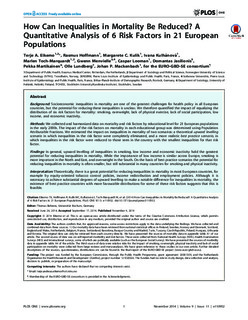| dc.description.abstract | Background:
Socioeconomic inequalities in mortality are one of the greatest challenges for health policy in all European countries, but the potential for reducing these inequalities is unclear. We therefore quantified the impact of equalizing the distribution of six risk factors for mortality: smoking, overweight, lack of physical exercise, lack of social participation, low income, and economic inactivity.
Methods:
We collected and harmonized data on mortality and risk factors by educational level for 21 European populations in the early 2000s. The impact of the risk factors on mortality in each educational group was determined using Population Attributable Fractions. We estimated the impact on inequalities in mortality of two scenarios: a theoretical upward levelling scenario in which inequalities in the risk factor were completely eliminated, and a more realistic best practice scenario, in which inequalities in the risk factor were reduced to those seen in the country with the smallest inequalities for that risk factor.
Findings:
In general, upward levelling of inequalities in smoking, low income and economic inactivity hold the greatest potential for reducing inequalities in mortality. While the importance of low income is similar across Europe, smoking is more important in the North and East, and overweight in the South. On the basis of best practice scenarios the potential for reducing inequalities in mortality is often smaller, but still substantial in many countries for smoking and physical inactivity.
Interpretation:
Theoretically, there is a great potential for reducing inequalities in mortality in most European countries, for example by equity-oriented tobacco control policies, income redistribution and employment policies. Although it is necessary to achieve substantial degrees of upward levelling to make a notable difference for inequalities in mortality, the existence of best practice countries with more favourable distributions for some of these risk factors suggests that this is feasible. | nb_NO |

